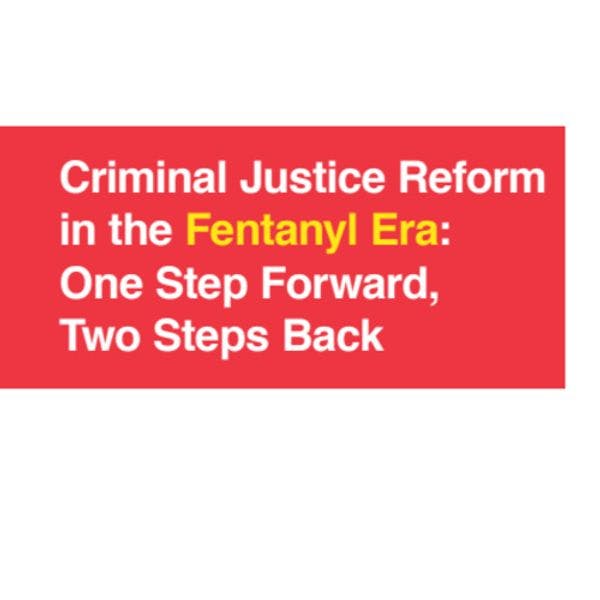Criminal justice reform in the fentanyl era: One step forward, two steps back
The U.S. is in the throes of a deadly overdose crisis that claimed almost 70,000 lives in 2018. Of those, around 30,000 deaths involved synthetic opioids like fentanyl,a Policymakers have responded to the overdose crisis with a rhetorical emphasis on “treatment instead of incarceration,” leading journalists to comment that we are in the midst of a “gentler war on drugs.” However, despite a change in discourse, draconian policies have persisted and in many cases been expanded. This is exemplified by many lawmakers’ reaction to fentanyl and other analog drugs, both on the state and federal level.
Since 2011, 45 states have proposed legislation to increase penalties for fentanyl while 39 states and Washington DC have passed or enacted such legislation. At this moment, some members of Congress are working to codify harsher penalties by placing fentanyl analogs permanently into Schedule 1 in both the Senate and the House with proposed legislation like the Stopping Overdoses of Fentanyl Analogues Act of 2019 (SOFA) and the FIGHT Act. In his annual State of the State 2020 address this month, New York’s Governor Cuomo proposed banning fentanyl analogs and expanding access to medication assisted treatment in the very same sentence. Legislators have dusted off the drug war playbook and proposed a variety of new punitive measures including new mandatory minimum sentences, homicide charges, involuntary commitment, expanded powers for prosecutors and more. These efforts repeat the mistakes that epitomize the failed war on drugs, while undermining efforts to reform our criminal justice system and pursue a public health approach to drug use. Indeed, such proposals risk compounding the overdose crisis.
Punitive approaches to fentanyl are particularly disturbing because they run counter to recent policy shifts that have been largely bipartisan in nature. One recent policy shift is a growing promotion of public health approaches to drug use. There is mounting support for a number of policies and interventions – such as increasing access to voluntary, medication-assisted treatment and naloxoneb – as more effective responses to the current overdose crisis than the revolving door of jail or prison. Another notable policy shift is the long-overdue recognition that decades of harsh and racially-biased drug enforcement have had devastating consequences on individuals and communities, while wasting billions of taxpayer dollars. A recent analysis of federal fentanyl sentencing revealed that 75% of all individuals sentenced for fentanyl trafficking were people of color, suggesting that fentanyl enforcement already mirrors other disparate drug enforcement.
The criminal justice reform movement has made tremendous progress on reducing drug sentences at the local, state and federal levels. The trend toward tougher penalties for fentanyl presents a threat to the reform movement, undercutting initiatives to reduce mass criminalization and incarceration. To date, none of the states that enacted harsher penalties for fentanyl, nor the federal government, have demonstrated a reduction in fentanyl-involved deaths because of these new laws.
In this context, the criminal justice reform movement must do more to combat punitive proposals, putting as much energy into challenging the exceptionalism around fentanyl as other efforts to reduce sentences.
This paper aims to shine a light on the danger that harsh fentanyl penalties present to the criminal justice reform movement and efforts to end the war on drugs:
- Harsh penalties for fentanyl are detrimental to public health and exacerbate the overdose crisis.
- People who use and sell drugs are often unaware of the composition and potency of their drugs and have little control over the quality of product available.
- Fentanyl in heroin is increasingly the “new norm” in many parts of the country.
- Lawmakers may believe they are addressing an issue that may pass with time, but fentanyl is no passing trend.
- There are already harsh penalties in effect for fentanyl and they disproportionately target communities of color.
- Differentiating between people who use and sell drugs is not possible.
The most effective ways to address the fentanyl crisis are evidence-based public health and harm reduction approaches. We recommend that policy makers and advocates focus their efforts to promote the following:
- Expand and protect 911 Good Samaritan laws,
- Expand community-based naloxone access and distribution,
- Expand Opioid Agonist Treatment (OAT),
- Improve drug checking, surveillance and data collection and make them more widely accessible,
- Authorize supervised consumption sites (SCS)c on the state and local level,
- Fund pilot injectable opioid treatment as an option for some people with chronic heroin use disorder.
For lawmakers to respond meaningfully to fentanyl, public health solutions are a much more viable and affordable approach without additional harsh penalties and further criminalization. The criminalization of drug use only drives people who use drugs into more dangerous situations. This makes it less likely that they will seek support; rather it makes it more likely that they will suffer a fatal overdose.
Advocates have made considerable gains in promoting criminal justice reforms to address the many collateral consequences of our failed war on drugs. While the criminal justice reform, treatment and harm reduction movements have many victories to celebrate, there is a real risk that the proliferation of harsh penalties for fentanyl will lead to an increase in the prison population, subverting the fight to end mass incarceration.
